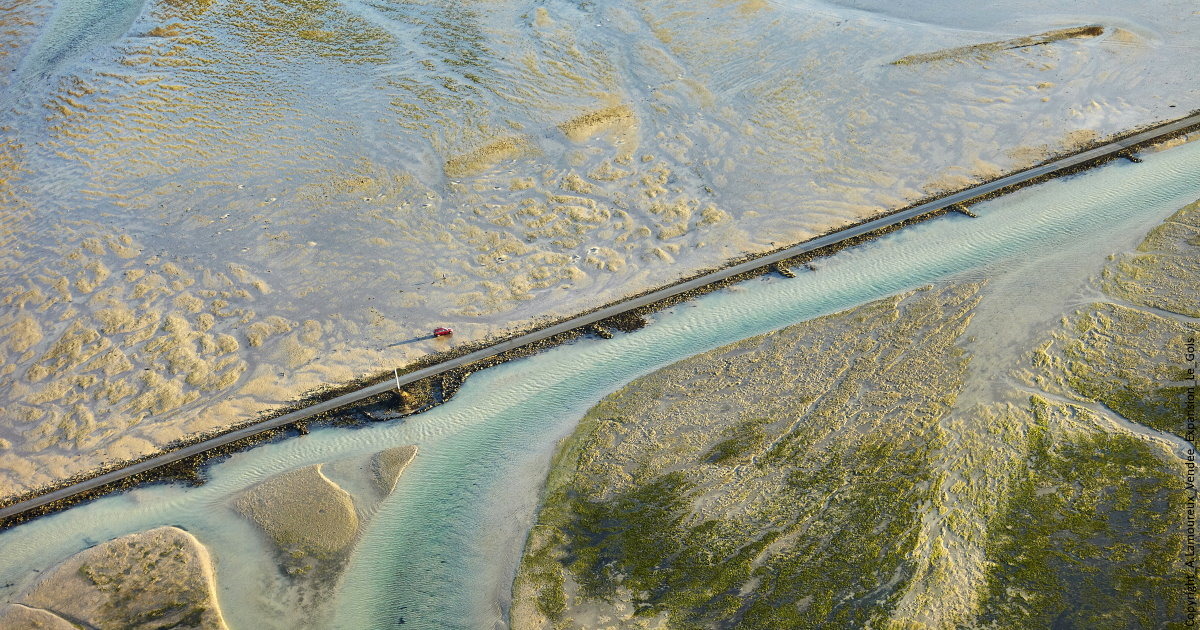
Passage du Gois, Vendéen road of mythic proportions
Nature's punishment –
Linking the mainland at Bauvoir-sur-mer on the gorgeous French Atlantic coast with Barbâtre on the Island of Noirnourtier is the Passage du Gois, or the Gois, a road that many will recommend avoiding at all cost. They are not wrong. While not the only tidal causeway in the world, or even in France, with a distance of 4.125km it is the longest.
When the tide comes in, the entire road simply vanishes from end to end. Being unfamiliar with the tide schedule is no longer an excuse to risk the journey even with the water barely creeping towards the road at first glance.
It seems like quite a leisurely natural phenomenon. It's a deception. Pay close attention and you'll see the tide come in to swallow the road at an alarming pace.
The only things between an overly adventurous soul and certain death by drowning, are the nine safety beacons installed in the 19th Century that can be used to seek higher ground until the water recedes again.
That nature can at times be punishing is nothing new. But it is quite something to see it happen right before your eyes.
Make it a day trip –
There is a lot to see and do on Noirmoutier and the island, while fantastic for a proper vacation, lends itself perfectly well for a daytrip. Plan ahead for specific things to see, or schedule a beach or culinary day. Whatever you do, don't miss driving across this famous road at least once in your lifetime!
For practical information and the amazing history of this road, please keep reading.
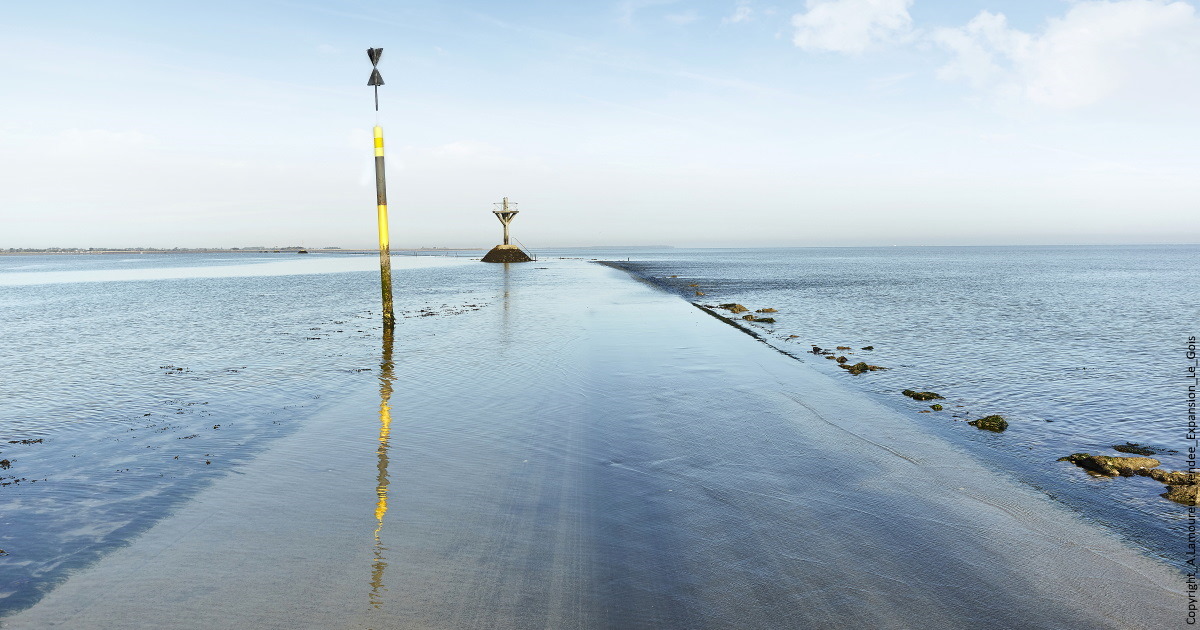
Tidal Causeway
According to folklore, the sea rises to the rhythm of a galloping horse. If your car happens to suddenly break down while traversing the road or if the warning sign that flashes "danger du mort" (danger of dying) somehow fails to imprint onto your retinas, the beacons with transverse bars and rungs were installed as safety measures. These can be used in cases of emergency to climb onto until the water recedes again. Six of the beacons seem like toothpicks jutting from the ocean, only three have actual platforms to stand on.
Several times each year rescue teams are deployed to save people from certain death by drowning. Water levels cannot always be gauged, they depend on weather patterns and tidal fluctuations.
But even at low tide the Passage du Gois is not easy to navigate. In addition to dodging cyclists and pedestrians, the road is almost too narrow for two cars to pass each other (too narrow for a U-turn in a big car), and is sometimes wet and covered in seaweed making it slippery.
Whether under the ocean or magically revealed, the Gois is a beautiful marine habitat to many species of birds in search of a meal or a restful gaze to take in the magnificent view.
Low tide is a draw for many a foot-fisher, people digging the wetlands in search of clams, oysters, and cockles.
Putting a definite stamp on the mysticism of is the Tour de France which has known its start here several times in recent years. Another sporting event is the Foulées du Gois, an annual international running race across the Gois.
Fair warning! To drive a car across this world famous road with the tide coming in you have to be a 50% reckless. 50% crazy, and 100% fearless with excellent driving skills.
The fact that people take on the challenge explains why nature is not the 'only' draw to the spectacle... Making it to the other side when the road is but a mirage on the horizon, before the road is completely undriveable is not for the faint of heart.
If that's the plan (which we urge you NOT TO DO) program the nearest car-wash into the GPS. In the long-term, the car is not going to appreciate the salt bath.
Keep reading for the incredible history of the Passage du Gois and for the reasons why you shouldn't miss being witness to the tides... from a distance!
Practical information
Open year-round – except at high tide
Maximum safety and clam digging – 90 minutes before and 90 minutes after low tide
Direction east – Beauvoir sur Mer
Direction west – Barbâtre
Length – 4.125km
GPS coordinates – 46° 55′ 51″ N, 2° 07′ 29″ O
Tide schedule – here
Noirmoutier via the D38/the bridge – directions & GPS
Images – Copyright_Simon_Bourcier_Passage_du_Gois_Noirmoutier
Copyright_A.Lamoureux_Vendee_Expansion_Le_Gois

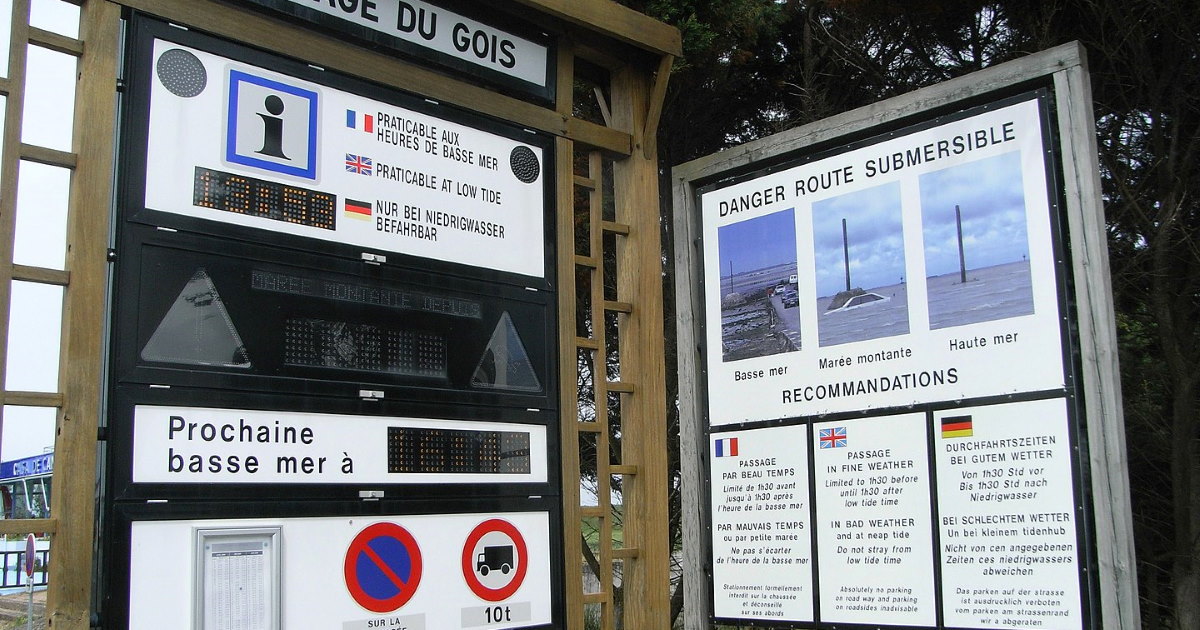
A story through millions of years –
At one time the island of Noirmoutier was connected to the mainland until the Bay of Bourgneuf collapsed. The Passage du Gois formed over countless years in the Quaternary period (earth's history as defined by the phenomenon of geological layering through millions of years) when in the Loire bassin two opposing ocean currents built up significant quantities of silt, forming an almost "natural" passage between the French mainland and the island of Noirmoutier.
- 9th Century (around 820) The Abbot of Saint-Philbert de Noirmoutier (under Emperor Louis the Pious) asked King Pépin of Aquitaine for protection of the island against Norman invasions. . Ermentaire, a monk from the island, wrote of Pépin's refusal in his memoirs "because one could not at all times bring help to the king as the Isle of Her was not always accessible by neap tides ”. Through this memoir became apparent that the Passage du Gois already existed.
- 843: Nantes prisoners on the Island of Her (then a base for Norman invaders) managed a daring escape to the mainland at low tide
- 17th Century: under Louis XIVth the island proved difficult to defend due to its position and intermittent access. Proof of this lies in a letter penned 25-2-1689 by Vauban, famed military architect in which he wrote...
..."the place in the kingdom where the businesses of the English and Dutch are most to be feared is by the bay of Bourgneuf near the Isle of Noirmoutiers because a naval army can remain there with as much security as in a port, as the Isle of Noirmoutiers which is only separated from the mainland by a small arm which sometimes sits up to be able to pass there on dry ground ... ”
- 1701: Passage du Gois appears on a map by Mr. Masse. At some point he described it as "the Route taken by foot people who pass in low water from the Isle of Noirmoutiers to the mainland, the bottom being of sand, mixed with a little mud and interspersed with small channels."
- 1766: said to be the first crossing of the Gois on horseback by Auguste Gauvrit, a tailor from Barbâtre. Boat service to and from Point de la Fosse was already present for a fee, but the passing on foot was free.
- 1780: Buoys are installed along the passage
- 1800: Early on in the 19th century it was determined the local government needed to pay the Passage du Gois more attention. The passage being muddy and dangerous was also at least 1km longer than it is now. People were dying trying to cross it.
- The official job of "Guard-Goa" was created, a person whose job was to maintain the Gois.
- The first infrastructure was created through "frondières", a sort of foundation on either side of the Gois by placing large pebbles.
- Lanterns were placed on either side to mark the exits
- These improvements mark the beginning of daily crossings with mail, couriers and travelers. Boat service is still available but in a diminished capacity.
- 1872: The passage was to be stoned and engineered.
- 1879: Beacons were with transverse bars and rungs were installed. These can be used by people in trouble to seek higher ground until the water recedes again.
- 1885: The road was stabilized and low walls were built on either side.
- 1886: An official route is assigned by the department... the Route de Napoléon-Vendée à Noirmoutier
- Start of the 20th century: Traffic was recorded as "100 horse drawn carts and 4 horse-drawn carriages per day; 10 automobiles per month; and per year 12,000 pedestrians, 600 cows, 600 horses and donkeys.
- 1922 - 1924: An initial paving of the road with a ramp on each exit
- 1935 - 1939: Engineer Louis Brien, widens the road, placing large stones 40cm x 40cm x 12cm weighing 20 to 30kg each (it has been paved again since
- WWII: Strategically located opposite the German submarine base at Saint Nazerre due north, Noirmoutier was occupied by the Wehrmacht. A special pass was needed to cross the Gois but rebellious Vendéens managed to smuggle and sneak past German checkpoints regardless!
- 1942: The Passage du Gois is classified as a historic site in the Vendée
- 1971: The bridge connecting the mainland to Noirmoutier is opened for traffic
- 1993: The Tour de France passes over the Gois for the first time. Most recently in 2018.
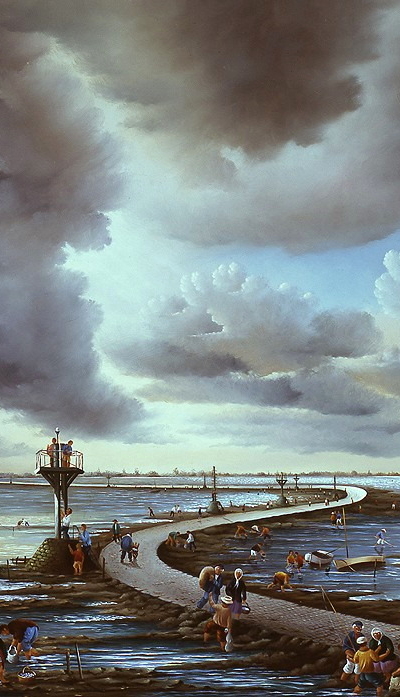
Painting of the Passage du Gois by famed French artist Raphael Toussaint
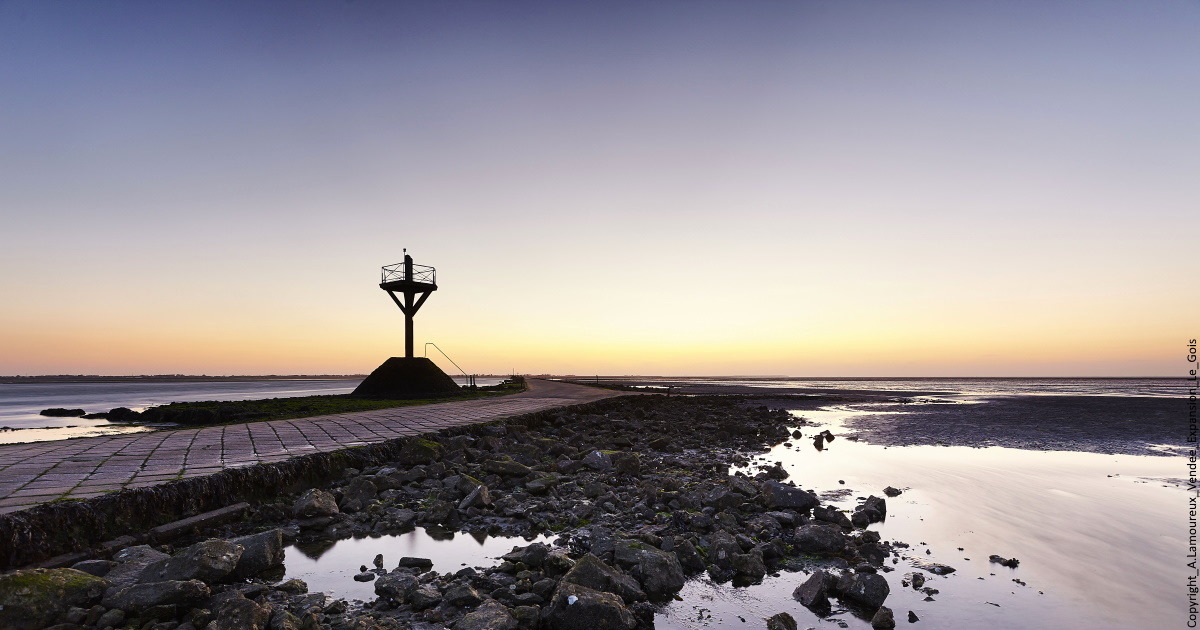
The adventure
Noirmoutier is a spectacular little island where the whole family will enjoy themselves. There is so much to see and do, and it's likely you'll blink twice upon arrival, thinking you've landed on a Greek island. You can reach the island year-round via the D38 and the big bridge at 85550 La Barre-de-Monts!
A spectacular activity for just about everyone who visits the Vendéen coast and/ or the island of Noirmoutier is to sit on either shore of the Passage du Gois to watch the tide come in. We highly recommend this... a spectacle of nature and adrenaline. And here are the reasons you should:
- appreciate nature ✔
- enjoy the coast ✔
- love learning ✔
- photography enthusiast ✔
- enjoy people watching ✔
- prefer adventure and danger at the distance ✔
- meeting new friends ✔
History of the Gois sources: various tourism sites, wiki sites
Share this Post
